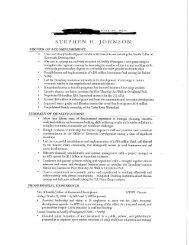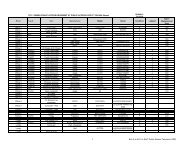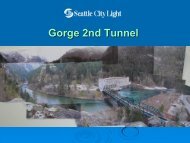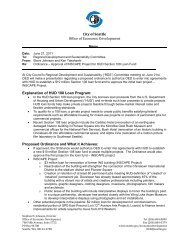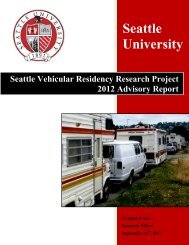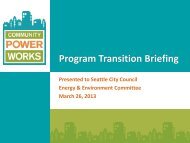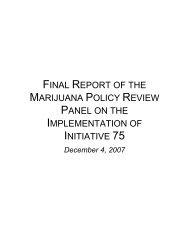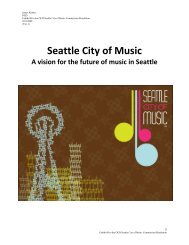2013 Water System Plan, Volume II - Seattle City Clerk's Office - City ...
2013 Water System Plan, Volume II - Seattle City Clerk's Office - City ...
2013 Water System Plan, Volume II - Seattle City Clerk's Office - City ...
You also want an ePaper? Increase the reach of your titles
YUMPU automatically turns print PDFs into web optimized ePapers that Google loves.
Passive Savings: Passive savings could be more or less than modeled. If the new clothes<br />
washer codes scheduled to go into effect in 2015 are reversed and market transformation<br />
towards fixtures and appliances that exceed code occurs slower than anticipated, passive<br />
savings could be less than estimated for the baseline forecast. Alternatively, if additional<br />
codes are passed in the future, market transformation takes place more quickly, and green<br />
buildings become the norm for new construction, passive savings could be more than<br />
estimated for the baseline forecast. A range of passive savings from 11.5 to 26.9 mgd (i.e.,<br />
plus or minus 40%) around the mean value of 19.2 mgd was chosen.<br />
Conservation Savings: The price/code/programmatic conservation overlap function is<br />
used to introduce an element of uncertainty to overall conservation savings. The baseline<br />
assumption is that 50% of the price effect overlaps with code and programmatic<br />
conservation. Assuming a higher level of overlap produces a smaller amount of total<br />
conservation savings, and vice versa. A range of conservation savings are obtained in the<br />
model by varying the overlap parameters between 25% and 75%.<br />
Modeling Uncertainty with @Risk: The uncertainty ranges described above are assumed to<br />
have normal or log-normal distributions, 8 with the endpoint values representing two standard<br />
deviations from the mean. These probability distributions become inputs to an aggregate<br />
uncertainty model using @Risk software (an add-in to Excel) which employs Monte Carlo<br />
simulation to characterize uncertainty around the official demand forecast. During each<br />
individual run of the Monte Carlo simulation, a value is randomly selected for each input variable<br />
based on the probability density function specified for that variable 9 . Then, the complete set of<br />
input values for that iteration is used to produce a water demand forecast. The simulation<br />
procedure performs a large number (10,000) of independent iterations, each generating a<br />
separate demand forecast. These forecasts are then pooled to obtain a probability distribution<br />
of forecast water demand through 2060.<br />
The results of the Monte Carlo simulation are displayed in the graph on the next page. The<br />
green bands indicate the range of uncertainty around the official forecast with each band<br />
representing a 5% change in probability. For example, the bottom of the lowest band<br />
represents the 5 th percentile. That means it’s estimated there’s a 5% chance actual demand will<br />
be below that point (and, thus, a 95% chance it will be above). The top band is the 95 th<br />
percentile which corresponds to an estimated 95% probability that actual demand will be below<br />
that point. Taking a cross-section of the graph at 2060 produces the probability distribution<br />
around the official forecast shown below.<br />
8 Log normal distributions are used for the uncertainty around household and employment growth and average<br />
annual rate of growth in water prices because the high and low ranges exhibit positive skewness (i.e., the highs<br />
are higher than the lows are low).<br />
9 All variables with uncertainty are assumed to be independent except for growth in households and employment.<br />
These are linked in the model because they would be expected to move together.<br />
FINAL Page 19 of 22 December 2011



